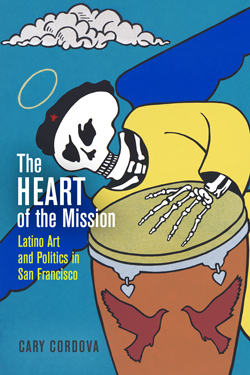Cary
Cordova
WRITING & RESEARCH
| HOME | PUBLIC HISTORY | CONTACT |
THE HEART OF THE MISSION
LATINO ART AND POLITICS IN SAN FRANCISCO
In The Heart of the Mission, Cary Cordova combines urban, political, and art history to examine how the Mission District, a longtime bohemian enclave in San Francisco, has served as an important place for an influential and largely ignored Latino arts movement from the 1960s to the present. Well before the anointment of the "Mission School" by art-world arbiters at the dawn of the twenty-first century, Latino artists, writers, poets, playwrights, performers, and filmmakers made the Mission their home and their muse.
University of Pennsylvania Press:
http://www.upenn.edu/pennpress/book/15634.html
On Amazon: https://www.amazon.com/Heart-Mission-Latino-Politics-Francisco-ebook/dp/B0711FSPJP
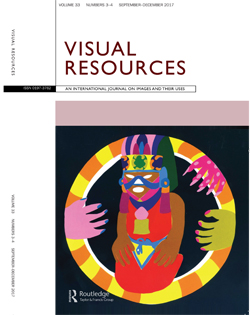
PORTABLE MURALS:
CHILDREN'S BOOK PRESS AND THE CIRCULATION OF LATINO ART
Online, May 26, 2017:
http://dx.doi.org/10.1080/01973762.2017.1277096
http://www.tandfonline.com/doi/full/10.1080/01973762.2017.1277096
Harriet Rohmer (b. 1938) created an independent publishing organization, Children’s Book Press, in 1975 to challenge the whiteness of mainstream children’s literature and to give inner city children alternative narratives to foster ethnic awareness and pride. The first 10 books, published between 1975 and 1978, entitled “Fifth World Tales,” became key to the non-profit’s growth into a major publisher of equitable children’s literature. This article shows how these first 10 books, ostensibly built on indigenous folklore of the Americas, also drew inspiration from the Latino communities of San Francisco, California. Most obviously, all 10 books featured the art of Latina and Latino muralists based in San Francisco’s Mission District, at the height of a flourishing community mural movement. Few street murals survived the flux of urban change, such that these children’s books represent an alternate, physically accessible illustration of this arts community, not unlike portable murals. Less obviously, it also reveals how the narratives of these books stemmed from the work of teacher and co-adapter Mary Anchondo (b. 1937) and from the parents and children of a Head Start pre-school classroom, as well as from a larger Latino intellectual community invested in myth and folklore. This article traces the unusual origins of these first 10 books, their publication as a federally funded effort to desegregate public schools, and these books as art objects of a Latino arts renaissance in San Francisco’s Mission District.
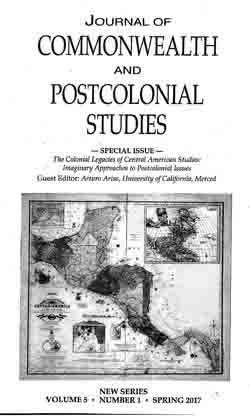
INTERPRETING CENTRAL AMERICAN-AMERICAN SPACES IN THE U.S. LANDSCAPE
Journal of Commonwealth and Postcolonial Studies, special issue – Central American-American Studies, Volume 5 (1), spring 2017.
This article examines how the built environment of the United States changed as a result of mass migrations from Central America during the 1980s. Moving from Washington, D.C., to Florida, Texas, and California, this analytic journey contemplates the ways U.S. empire frames the history of Central Americans living in the United States.
DOWNLOAD HERE: CaryCordova.com/Cordova_MarkingSpace.pdf
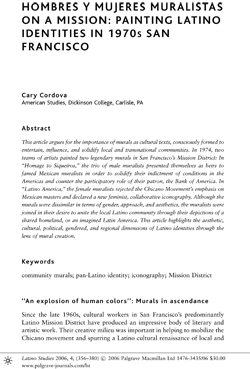
PAINTING LATINO IDENTITIES IN 1970s SAN FRANCISCO
Latino Studies, winter 2006, 4 (4), 356-380.
http://www.palgrave.com/us/journal/41276
https://link.springer.com/article/10.1057/palgrave.lst.8600223
This journal article was revised and incorporated into The Heart of the Mission: Latino Art and Politics in San Francisco (2017).
This article argues for the importance of murals as cultural texts, consciously formed to entertain, influence, and solidify local and transnational communities. In 1974, two teams of artists painted two legendary murals in San Francisco's Mission District: In “Homage to Siqueíros,” the trio of male muralists presented themselves as heirs to famed Mexican muralists in order to solidify their indictment of conditions in the Americas and counter the participatory role of their patron, the Bank of America. In “Latino America,” the female muralists rejected the Chicano Movement's emphasis on Mexican masters and declared a new feminist, collaborative iconography. Although the murals were dissimilar in terms of gender, approach, and aesthetics, the muralists were joined in their desire to unite the local Latino community through their depictions of a shared homeland, or an imagined Latin America. This article highlights the aesthetic, cultural, political, gendered, and regional dimensions of Latino identities through the lens of mural creation.
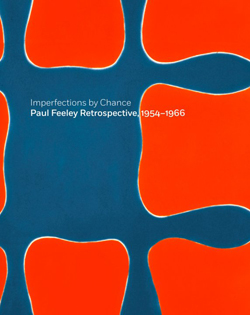
TRACING A LIFE
A FEELEY CHRONOLOGY
In Douglas Dreishpoon, ed., Imperfections by Chance: Paul Feeley Retrospective, 1954-1966. London: D Giles Limited. 233-246.
https://gilesltd.com/books/catalogue/exhibition-catalogues/imperfections-by-chance
"Paul Feeley (1910–1966) is a towering figure in postwar American modernism. His legendary tenure as head of the art department at Bennington College and resulting associations with the likes of Lawrence Alloway, Helen Frankenthaler, Clement Greenberg, Jackson Pollock and David Smith, informed his unique approach to painting as an open-ended proposition. Represented during his lifetime by the Betty Parsons Gallery and honoured posthumously by a retrospective at the Solomon R. Guggenheim Museum, he is the subject of this timely new publication, which accompanies a major exhibition organized by the Albright-Knox Art Gallery. In addition to colour plates of all works in the exhibition—nearly one hundred paintings, works on paper and sculptures—this volume features essays by exhibition curator Douglas Dreishpoon, Tyler Cann and Raphael Rubinstein as well as an illustrated chronology by Cary Cordova. From his early Abstract Expressionist–inspired paintings to his organic, anthropomorphic figure–ground compositions and later diagrammatical, hard-edged works, Imperfections by Chance charts the full range of Feeley’s influential life and career."
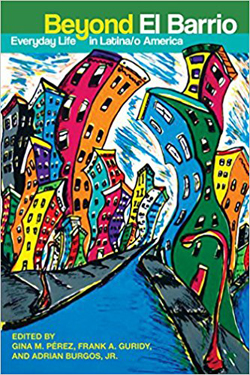
SAN FRANCISCO POETS GO TO WAR
In Gina M. Perez, Frank Guridy, and Adrian Burgos, eds., Beyond El Barrio: Everyday Life in Latina/o America. New York, NY: New York University Press. 211-231.
https://nyupress.org/books/9780814791295/
This book chapter was revised and incorporated into The Heart of the Mission: Latino Art and Politics in San Francisco (2017).
From the introduction of Beyond El Barrio: "Cary Cordova’s contribution explores the different ways Latina/o cultural workers asserted their solidarity with the people of Nicaragua, regardless of whether they were of Nicaraguan origin. Pro-Sandinista sentiment flourished in San Francisco as a result of its large Nicaraguan immigrant community, the devastating 1972 earthquake in Managua, and the 1973 U.S.-engineered coup in Chile. As cultural workers organized to promote an alternate, socialist form of government in Nicaragua, they also stood in opposition to the diplomatic objectives of the U.S. government. These interactions, Cordova argues, had a profound impact on Latina/o artists who decided that their place was in Managua, both literally and figuratively. Using oral histories and careful archival research, Cordova explores the galvanizing impact of Central American movements on the aesthetics and cultural work of various Mission-based artists. Working with poems and images created during the existence of the Neighborhood Arts Program, Cordova argues that the wars in Central America expanded Latina/o artists’ vision of themselves. Their efforts contributed to the success of the Sandinista revolution and merit examination, perhaps even more so now, as the language of U.S. patriotism attempts to extinguish such forms of activism."
Artist Profiles
Cordova, Cary (2008). “Yolanda López.” Women’s
Caucus for Art: Honor Awards for Lifetime Achievement in the Visual Arts. Dallas,
TX: College Art Association, Women’s Caucus for Art, Honor Awards 2008. 17-20.
Cordova,
Cary (2005). “The Paintings of Liliana Wilson.” Voices of Art, 13 (1), spring,
28-29.
Encyclopedia Entries and Reference
Cordova, Cary (2010). “Culture Clash,” In David J. Leonard and
Carmen Lugo-Lugo, eds., Latinos and Latinas in U.S. History and Culture: An Encyclopedia.
Armonk, NY: M.E. Sharpe. 152-154.
“Exhibition History and
Bibliography.” In Lane Relyea, ed., Paul Feeley: Painting and
Sculpture (exhibition catalog, October 5-November 23, 2002). New York: Lawrence
Markey Gallery and Matthew Marks Gallery. 99-103.
